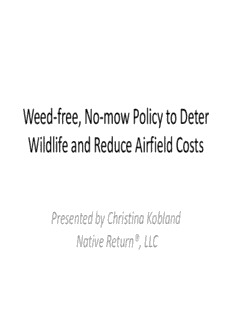
Weed-free, No-mow Policy to Deter Wildlife and Reduce Airfield Costs PDF
Preview Weed-free, No-mow Policy to Deter Wildlife and Reduce Airfield Costs
Weed-free, No-mow Policy to Deter Wildlife and Reduce Airfield Costs Presented by Christina Kobland Native Return®, LLC Ideal airfield vegetation qualities • Minimizes wildlife activity • Easy to manage (economical) • Low environmental impact What are we planting on our airfields? Perennial Kentucky Bluegrass- Ryegrass- Very common and like This commonly candy to Canada geese. planted airfield turf is a valued food source for many animals. Clover- Often mixed with many turfgrasses and Millet- valued by many Sometimes animals including planted on deer airfields and is found in birdseed! Innovation High endophyte tall fescue and perennial rye Upside: • Bird deterrent, if maintained weed free Downside: • Requires constant mowing • Questionable long term viability • Unknown environmental side effects USDA recognizes mowing is a wildlife hazard “… mowing is a maintenance expense that also produces greenhouse gases, counteracting recent industry initiatives to improve environmental sustainability at airports. In addition, mowing often attracts hazardous species, such as cattle egrets (Bubulcus ibis), European starlings, and raptors that feed in the wake of the mowers. (McAllister 2009, Infanger 2010).” -USDA, Wildlife Services Fine fescue grass…a better option? • Traditionally used in shade mixes • Low growing • Weed resistant • Low fertility requirements • Improved fine fescue mixture, tested on airfields • Varieties selected for wildlife deterrence • Thrives in full sun, drought tolerant, attractive • FlightTurf® method is covered by US patent # 8,789,310 - 4 additional patents pending Philadelphia Division of Aviation Alternative Airfield Turfgrass Study 2009 – 2012
Description: